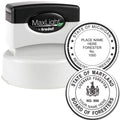Have you ever wondered how you can clearly mark products, documentation, or quality checks in one swift motion? A safety inspection stamp is the simple yet powerful tool that ensures your processes stay transparent and consistent. After all, a clear and accurate marking system instantly identifies items that have passed, need rework, or require attention. In this article, we’ll explore what makes a safety inspection stamp so essential, what to look for when picking one out, and how to maintain it for best results. By the end, you’ll have practical tips for choosing a top-quality stamp and keeping it in excellent condition.
Understand Safety Inspection Stamps
A safety inspection stamp is a small but mighty resource for businesses in manufacturing, warehousing, product assembly, and more. It creates a quick visual cue that your team has checked a product’s quality, safety, and readiness for shipping or further processing. That’s why it plays such a big role in a well-run system: it leaves no doubt about whether a product meets your established standards.
Why a Stamp Matters
- Streamlines your inspection process.
- Helps your team and customers see at a glance if items passed or need a second look.
- Maintains a record of responsibility (who did the inspection and when).
When everyone on your team uses the same standardized method of marking, you reduce confusion, errors, and miscommunication. A stamp is also more durable than a handwritten note, so your safety sign-offs won’t fade or smudge easily.
Key Benefits Of A Reliable Stamp
Not all stamps are created equal. Some might fade over time, clog with ink, or crack under heavy usage. So what sets a reliable inspection stamp apart?
Consistent Imprints
If you’re using a custom stamp daily, you need consistent marks without blotches or uneven coverage. That consistency builds trust within your team: they know that if something’s stamped “passed,” the result is legitimate.
Durability And Longevity
Whether you’re in a busy warehouse or a small office, reliability is vital. Quality stamps can last months or even years with proper care. They’re built to handle repetitive motions and frequent re-inking without breaking down.
Ease of Use
A good inspection stamp should fit comfortably in your hand and offer a quick imprint. If it’s too large or oddly shaped, you’ll tire out faster, and your markings might become sloppy. You want something that’s fast, lightweight, and ergonomic.
Possible Issues When Poorly Designed
- Hand fatigue: leads to rushed inspections and possible mistakes.
- Ink leakage: leaves messy marks and can ruin documents or surfaces.
- Inconsistent images: each imprint looks different, creating confusion over a product’s status.
Consider Materials And Ink Options
Inspection stamps come in different makes and models, each with its own set of pluses and minuses. Understanding the materials helps you pick the one that fits your environment, whether that’s a hot manufacturing area or a standard office.
Common Stamp Types
Below is a quick rundown of popular types you might consider.
| Stamp Type | Features | Ideal Usage |
|---|---|---|
| Self-Inking Stamp | Built-in ink pad, typically water-based | Medium-volume usage, office environments |
| Pre-Inked Stamp | Ink embedded in the stamp die for crisp detail | High-volume usage needing precise imprints |
| Traditional Stamp | Separate pad, can use specialized inks | Industrial settings or for custom colors |
Self-Inking
These often suit moderate usage, since they have a handy internal ink pad. You just press down and the stamp re-inks itself. The downside? The internal pad can dry out if left unused for long stretches, but re-inking is usually straightforward.
Pre-Inked
Pre-inked options are known for giving fine, detailed images. They can handle more impressions before they need replenishing. If you produce thousands of products, these stamps might be your go-to. However, they can cost slightly more upfront.
Traditional
They’ve been around for years, requiring a separate ink pad. While less convenient, they offer loads of versatility—particularly useful if you need quick color changes or specialized inks for specific surfaces.
Ink Types
- Water-based: Quick-drying, low odor, best for paper surfaces.
- Oil-based: Suitable for industrial environments, especially if you have to stamp onto plastic or metal.
- Specialty: Sometimes you need quick-dry or permanent inks, especially if your products endure tough conditions or get handled frequently.
Customize For Personalization And Branding
If you’re looking to stand out, a customized stamp can do wonders. It’s not just about marking something as “passed” or “inspected.” You can add your brand identity, unique text, or date information to ensure complete clarity.
- Include your company’s name: This builds trust and provides extra assurance to clients or external inspectors.
- Insert a date or timestamp: Helpful for logging when inspections took place.
- Incorporate your logo: If you want to tie your inspection process to your visual identity, you can explore a customized company logo inspection stamp for maximum brand consistency.
Most providers, like ESS, let you personalize font styles, shapes, and sizes so your marks look exactly the way you want.
Tips For Selecting The Right Stamp
Feeling ready to pick your safety inspection stamp, but not sure what to prioritize? Let’s be honest, it can get overwhelming with all those options out there. Here are a few key points to consider.
Define Your Usage Level
Ask yourself: how often will you use this stamp? A low-volume user might press it just a few times a day, while a high-volume user could mark hundreds of items in a single shift.
- If you handle large batches daily, consider a pre-inked stamp with a reliable grip.
- If your usage is light, a self-inking option might be enough.
Evaluate Ink Requirements
The environment you’re dealing with matters. Office-based stamping on standard copy paper differs wildly from stamping on plastic in a hot warehouse.
- For typical office documents, a water-based ink suffices.
- For industrial settings, opt for an oil-based or quick-drying formula.
Check Supplier Reputation
Stamps vary significantly in build quality. It’s wise to choose a provider known for durable, high-quality products and customer support. ESS, for instance, has been around since 1964, offering custom inspection stamps, QA stamps, and QC stamps with a level of expertise that’s hard to match.
Confirm Replacement Options
Eventually, you’ll need a refill or even a new die for your stamp. Make sure your provider offers easy replacements and quick shipping. A good supplier should be able to handle orders swiftly, so you spend less time waiting and more time marking.
Proper Usage And Maintenance
Even the best safety inspection stamp performs better with a little TLC. Here’s how to keep your stamp in tiptop shape so it can serve you optimally for as long as possible.
Use The Right Technique
- Press firmly and evenly onto your surface.
- Avoid rocking the stamp, which can smudge the mark.
- Keep your wrist and arm aligned with the stamp to reduce fatigue.
Cleaning And Storage
- Wipe the stamp face periodically with a slightly damp cloth (no harsh chemicals).
- Store it away from direct sunlight, which can dry out the ink faster.
- For traditional stamps, cover the pad to prevent dust and debris from accumulating.
Re-inking Steps
- Open or remove the built-in pad (for self-inking or pre-inked stamps).
- Use only the recommended ink type to avoid clumping or discoloration.
- Carefully apply a few drops at a time, allowing the ink to absorb.
- Test the stamp on scrap paper to make sure the imprint is crisp and clear.
The ESS Advantage
Choosing a stamp provider might feel like a gamble, but when you work with ESS, you’re leveraging decades of experience in delivering quality inspection stamps. We’re a family-owned business that has been operating since 1964, so you can count on both expertise and personal touch. Our goal is straightforward: to make sure you get the perfect stamp that’s easy to use, built to last, and fits your brand.
Why ESS Stands Out
- Top Notch Supplier: We specialize in custom inspection stamps, QA stamps, and QC stamps that meet professional standards.
- Excellent Customer Service: Have questions or special requests? We’re here to help with real, friendly advice for your stamping needs.
- Fast Turnaround: We know time is crucial. Our quick production and shipping times get your stamp in your hands ASAP.
- Family Owned and Operated: We take pride in our heritage, giving you a warm and personal experience rather than a cold, corporate approach.
Working with ESS also means you can easily incorporate your branding. If you want your company logo on your inspection stamp, we do that seamlessly. Just check out our company logo inspection stamp to dress up your mark in style.
FAQs
Why Use A Custom Safety Inspection Stamp Instead Of A Standard One?
A custom stamp can highlight specific information relevant to your products, such as unique pass/fail criteria or your company’s logo. Standard stamps might say only “Inspected” or “Approved,” but a custom stamp can include your brand, date, user initials, or any other essential details.Which Materials Are Best For A Safety Inspection Stamp?
It depends on your environment and usage. Self-inking stamps are great for moderate office use, while pre-inked stamps are perfect for high-volume tasks. Traditional stamps require a separate pad, making them suitable for versatile ink needs, including oil-based or specialized formulations.Can I Include My Company Logo On The Stamp?
Absolutely. A custom stamp is all about personalization. By adding your logo, you reinforce brand identity and let clients or inspectors know that your process meets specific standards. Check out our easy company logo inspection stamp option to see how that works.What Color Ink Works Best For Inspection Stamps?
Typically, black or red ink is used for clarity and visibility, but it truly depends on contrast. If your product or paperwork is already dark, you might go for a brighter color like blue. The key is ensuring the mark is readable in your specific environment.How Fast Can ESS Deliver A Custom Stamp?
We understand urgency. ESS has a reputation for fast turnaround times. Once you’ve confirmed your design, our team sets to work creating a stamp built to your exact specs. Many orders ship quickly, so you can start using your new inspection stamp without delay.
By now, you’ve got a sense of how good inspection stamps boost efficiency, clarity, and professionalism. From choosing the right materials to fine-tuning your design, each step influences how effectively you can mark your goods and documentation. And if you’re looking for a down-to-earth stamp supplier that’s got decades of experience and an unbeatable personal touch, ESS is eager to help. After all, a well-chosen safety inspection stamp is more than just ink on a product, it’s your official seal of quality.


















